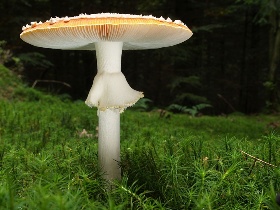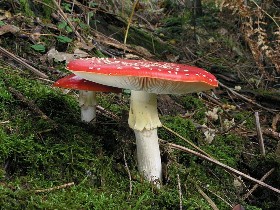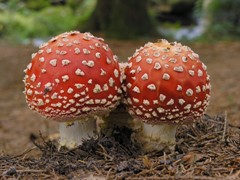
Adaptations
To survive and improve its quality of life, A. muscaria has developed a number of adaptations. These adaptations may have popped up on previous pages, but below I will discuss them in more detail.
-
Gills and Basidium
A. muscaria produces tons of spores in hopes that some will carry on the species. I have come across a number of adaptations that optimize the distribution of basidiospores.


The two images above are perfect examples of these adaptations. Notice the abundance and dense packing of the gills. This alone provides lots of room for basidiospores to be produced and stored.
The orientation of the basidium and gills is also very important. Over the years, A. muscaria has adapted so that today its gills are oriented in a near-perfect vertical fashion. Its cap also orients in such a fashion. If placed on its side, the stem of A. muscaria will bend away from the ground through a process known as negative gravitropism (bending away from gravity). This orients the cap so that the cap is parallel to the ground and the gills are facing down. These two adaptations maximize the range for spore distribution. -
Ectomycorrhizae
As I stated before, A. muscaria is one-half of a very important symbiotic relationship with trees known as ectomycorrhizae. Because, in many cases, the tree and A. muscaria are dependent on each other for water and sugar, respectively, this is an obligate mutualism relationship. -
 To
create this relationship, the hyphae of A. muscaria
form a sheath around the roots of the tree. This sheath,
referred to as the mantle, gives the roots a club-shaped
appearance. This adaptation greatly increases the surface
area at the roots, thus maximizing water uptake.
To
create this relationship, the hyphae of A. muscaria
form a sheath around the roots of the tree. This sheath,
referred to as the mantle, gives the roots a club-shaped
appearance. This adaptation greatly increases the surface
area at the roots, thus maximizing water uptake. -
To provide a method of nutrient exchange, the hyphae of A. muscaria penetrates the cells of the cortex in the root. Through this adaptation, known as the Hartig net, A. muscaria is able to exchange water and vital nutrients for sugars produced by the tree via photosynthesis.
Now that you've reached the end of the adaptations, it's time to learn some Interesting Facts about A. muscaria.